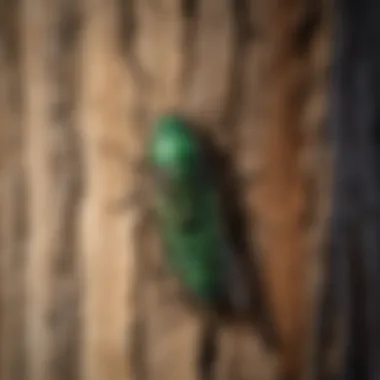Understanding Ash Borer Treatment Costs: An In-Depth Guide


Intro
The emerald ash borer is a small but devastating insect that has created significant challenges for forestry professionals and woodlands. Understanding the cost of treatment for infestations is essential for effective management and preservation of affected trees. This article will explore various factors that influence treatment costs, including biological impacts, available treatment options, and the long-term financial implications for both forestry practices and woodland stewardship.
Understanding Woodland Ecosystems
Importance of Biodiversity in Forests
Woodland ecosystems are vital for maintaining biodiversity. Diverse ecosystems support various species of flora and fauna, which contribute to the resilience and health of the environment. When ash trees are affected by the emerald ash borer, it impacts not just the trees but the entire ecosystem. Loss of tree species can lead to habitat loss for animals and disrupt the intricate balance between species that rely on these trees for survival.
Role of Forests in Climate Regulation
Forests play a critical role in regulating the climate. They act as carbon sinks, absorbing carbon dioxide from the atmosphere. When trees die or are infested, the balance of carbon absorption is disrupted. This loss can exacerbate climate change effects. Hence, understanding how to treat and manage ash borer infestations is crucial not only for preserving trees but also for maintaining climate stability and promoting overall environmental health.
Sustainable Forestry Practices
Principles of Sustainable Forestry
Sustainable forestry practices focus on maintaining the health of forest ecosystems while meeting current and future needs for forest resources. This includes managing ash borer infestations in a way that minimizes ecological disruption. Foresters must assess the health of the woodland before deciding on the management approach. Methods may include selective tree removal, chemical treatments, or biological controls—each with its own cost implications.
Case Studies of Successful Implementations
Successful management strategies provide valuable insight into effective treatments. One case study involves the use of insecticides to protect high-value ash trees in urban settings. These targeted applications, although initially costly, can save significant amounts in the long run by preserving the ecosystem services that these trees provide. Another example is the introduction of natural predators, which can help control the ash borer population and reduce treatment costs over time.
Woodland Stewardship Techniques
Forest Management Plans
A well-defined forest management plan is crucial for addressing ash borer infestations. These plans should include regular monitoring and assessment of tree health, prioritization of treatment methods, and budgeting for treatment costs. By planning proactively, woodland owners can make informed decisions, reducing the urgency and expense of treatment down the line.
Conservation Strategies
Conservation strategies are effective in enhancing forest resilience against pests and diseases. This involves mixed-species planting, maintaining healthy soil ecosystems, and ensuring that water resources are managed sustainably. Educating local communities about the significance of these strategies can also foster better stewardship and collective efforts toward managing ash borer impacts effectively.
"Understanding the cost implications of treatment options is critical for making informed decisions in woodland management."
Prologue to Ash Borer
The presence of the emerald ash borer (EAB) has become a critical concern in forestry management and conservation efforts across North America. This tiny beetle brings with it significant biological and economic impacts that can drastically affect ash tree populations. Understanding the implications of an EAB infestation is crucial for both the ecological balance and the economic vitality of woodlands.
Effective management of this pest requires a thorough comprehension of the infestation dynamics and treatment options. The variety of treatment strategies represents an investment not just in tree health but also in the overall health of the ecosystem. This understanding helps forestry professionals prioritize actions accordingly.
In this section, we will explore key aspects related to the emerald ash borer, including an overview of the insect itself and its biological effects on ash trees. Both of these facets are essential for informed decision-making surrounding mitigation tactics and cost-effective treatment options.
Emerald Ash Borer Overview
The emerald ash borer is an invasive species native to Asia. It was first identified in the United States in Michigan in 2002. This beetle primarily targets ash trees, and its larvae feed beneath the bark, disrupting the tree's ability to transport water and nutrients. The beetles themselves are bright green and about half an inch long, making them somewhat small and easily overlooked.
A significant aspect of their life cycle is their rapid reproduction. A single female can lay up to 200 eggs, leading to rapid population growth and larger-scale infestations. The spread of the EAB has been facilitated by human activities, particularly through the movement of untreated firewood and nursery stock.
Biological Impact on Ash Trees
The biological impact of the emerald ash borer is profound. Infested trees often exhibit a range of stress symptoms, including:
- Canopy dieback: As the larvae consume inner bark, tree canopies begin to thin, reducing overall vigor.
- Bark splitting: As the bark is disrupted, trees experience structural damage.
- Suckering: Trees may attempt to compensate for damage by producing new growth near the base.
Studies estimate that without effective treatment or management, most ash trees in affected areas will die within a few years of infestation.
The cascading effects of these biological changes can lead to a loss of biodiversity, as ash trees play a crucial role in forest ecosystems. Understanding these impacts is pivotal for effective forest stewardship and necessitates a proactive approach to treatment planning.
Identifying Infestation
Identifying infestation is a crucial aspect of managing ash borer populations. Early detection can significantly influence treatment outcomes as well as costs. Understanding the signs of emerald ash borer activity allows property owners and forestry professionals to take prompt action. Moreover, assessing the health of the trees can inform decisions on the most effective treatment strategies. In the following subsections, we will focus on specific signs indicating ash borer activity and the best ways to evaluate tree health.


Signs of Ash Borer Activity
Recognizing signs of ash borer infestation is essential for managing the threat to ash trees. Some common indicators to be aware of include:
- D-shaped holes: Adult emerald ash borers exit the tree through characteristic D-shaped holes, around 1/8 inch in diameter.
- Serpentine galleries: The larvae create distinctive tunneling patterns inside the bark, which can be observed by peeling back the bark. These galleries can be light-colored and often appear wavy.
- Crown dieback: Initially, leaves may become sparse and turn yellow, indicating that the tree is struggling. This dieback usually starts at the top of the tree.
- Frass: This is a term for the sawdust-like material produced by the insects, which can sometimes be found at the base of infested trees.
By being vigilant about these signs, landowners can act quickly to mitigate the infestation.
Assessing Tree Health
Assessing tree health is an essential process that complements the identification of ash borer activity. Understanding the overall health of the tree can provide crucial insights into its potential recovery and the need for expensive treatments. Here are some considerations:
- Visual examination: Look for discoloration, premature leaf drop, or unusual growth patterns, which might indicate stress.
- Soil condition: Ensure that the soil surrounding the tree is not compacted and retains adequate moisture.
- Other pests: Check for the presence of secondary pests, which often capitalize on weakened trees.
A thorough health assessment can guide decisions about whether a tree should be treated or removed. Healthy trees might respond better to treatments, making long-term management more feasible.
Early identification and assessment of infestation can save significant expenses in treatment and help preserve the ecological integrity of affected woodlands.
Treatment Options for Infestation
Effective treatment of ash borer infestation is critical to managing and preserving ash tree populations. Each treatment option carries its own set of advantages and limitations, making it essential for forestry professionals and landowners to understand the available methods in order to make informed decisions. This section delves into the types of treatments available, highlighting preventive strategies, chemical approaches, and biological control methods.
Preventative Treatments
Preventative treatments play a vital role in safeguarding ash trees from emerald ash borers before an infestation occurs. Implementing these strategies can mitigate potential damage and reduce the need for more drastic measures later.
Some common preventative treatments include:
- Insecticides such as systemic products, which are absorbed by the tree and target larvae feeding within the bark.
- Trenching to create a protective barrier against borers.
- Regular health assessments of trees to monitor for signs of weakness.
It is important to consider the timing of these treatments. Ideally, they should be applied before the adults emerge in spring when trees are actively growing. By focusing on prevention, landowners can enhance the health and durability of their ash trees while also controlling costs.
Chemical Treatments
Chemical treatments are often the most immediate solution once an infestation is detected. Various insecticides can be effective in combating emerald ash borers. These treatments not only target existing infestations but can also reduce future populations.
Common chemical options include:
- Systemic insecticides, like imidacloprid, which penetrate the tree's system and are effective against feeding larvae.
- Contact insecticides that kill borers upon contact but may require multiple applications.
However, applying chemical treatments requires meticulous attention. Factors such as tree health, the extent of infestation, and environmental considerations must be assessed before proceeding. Additionally, there are regulations governing the use of insecticides, necessitating that professionals stay informed about local environmental guidelines.
Biological Control Methods
Biological control methods are an emerging area of interest in managing ash borer populations. These techniques utilize natural predators or pathogens to control invasive species and can offer a sustainable solution in the long term.
Examples of biological control include:
- Introducing parasitoid wasps that lay eggs in emerald ash borer larvae, thus reducing their populations.
- Utilizing microorganisms that specifically target borers while minimally affecting other species.
Implementation of these methods requires thorough planning and understanding of local ecosystems. Success also relies on the establishment of a stable predator-prey relationship over time.
Factors Influencing Treatment Costs
The costs associated with treating ash borer infestations can vary significantly based on several critical factors. Recognizing these factors is essential for effective financial planning in both remediation efforts and long-term woodland management. Each element not only drives the immediate expenses but also shapes the overall strategy for managing ash populations affected by the emerald ash borer. Understanding these costs allows landowners and management professionals to make informed decisions that could lead to more sustainable forestry practices.
Scale of Infestation
The scale of the infestation is one of the foremost determinants of treatment costs. The extent of damage to the trees directly affects the complexity and duration of the treatment required. When an infestation is localized, expenses may be confined to a few trees, making management easier and less costly. However, in cases where the infestation has spread widely, a more comprehensive approach is necessary.
- Localized Infestation: Treatment may involve targeted chemical application or removal of a small number of affected trees. This often incurs lower costs.
- Widespread Infestation: Such scenarios require extensive services, including aerial surveys, chemical treatments over larger areas, and potentially the removal of numerous trees. This dramatically raises expenses.
It is noteworthy that early detection can significantly reduce costs. When infestation levels are low, proactive measures can often stop the problem before it becomes extensive.


Type of Treatment Chosen
The type of treatment chosen impacts costs considerably. There are varied approaches for dealing with ash borer infestations, each with distinct cost implications:
- Preventative Measures: These treatments might involve pesticide applications, which could range from moderate to high in price, depending on the products used and frequency of application.
- Chemical Treatments: These may be necessary for existing infestations. Costs can escalate based on the chemicals selected, their effectiveness, and any required follow-up treatments.
- Biological Control Methods: Often more environmentally friendly, these methods may still carry costs for research, implementation, and monitoring to measure their success.
Each type of treatment should be evaluated not just on immediate costs, but also on long-term efficacy and ecological impact.
Accessibility of Treatment Sites
The accessibility of the treatment sites plays a crucial role in determining overall treatment costs. Areas that are hard to reach, such as steep terrains or densely wooded locations, can incur additional expenses. This may include increased labor costs or specialized equipment needed to facilitate treatment.
- Urban Areas: Treatments in urban settings may face restrictions or complications due to nearby structures and utilities, often requiring more planning and potentially higher costs.
- Remote Forest Areas: While less obstructed, remote sites might demand more time and resources to transport equipment and personnel, thus influencing costs.
In essence, the logistical challenges presented by the site conditions must be assessed, as they can greatly influence the final expense incurred by the landowner.
Labor and Professional Fees
Another significant component of treatment costs involves labor and professional fees. Hiring experienced professionals is often necessary to ensure effective intervention. Labor costs can differ widely, influenced by the expertise required and the wage rates in the area.
- Professional Arborists: The fees for certified arborists can be substantial, but their knowledge is invaluable in precisely diagnosing the infestation and determining the best treatment options.
- Labor Rates: Local market conditions can also affect labor costs, where demand for skilled arborists may drive up prices.
The use of professionals may initially seem expensive, but their expertise could prevent greater future losses, making their services a wise investment in many cases.
Understanding the factors that influence treatment costs allows forestry professionals to make calculated decisions. A proactive approach to managing infestations may yield greater long-term savings.
In summary, the treatment costs for ash borer infestations hinge upon multiple interrelated factors, including the scale of the infestation, type of treatment, site accessibility, and labor costs. These components require careful consideration when planning both immediate responses and longer-term management strategies.
Cost Estimates for Popular Treatments
Understanding the cost estimates for popular treatments against ash borer infestations is crucial for landowners and forestry professionals alike. Effective management of these infestations not only requires knowledge of potential treatments but also a concrete understanding of the costs associated with each option. This section will provide insights into average costs and compare various treatment methods, highlighting economic factors that influence decision-making. Making informed choices can ultimately preserve both the trees and the value of the forested land.
Overview of Average Costs
When assessing the costs of treating ash borers, treating options can vary significantly. Generally, preventative treatments, such as insecticides applied as soil drenches or injections, can range from $100 to $300 per tree depending on factors like tree size and treatment frequency. Meanwhile, chemical treatments commonly administered after infestation can run anywhere from $200 to $600 per tree.
Biological control methods, which often involve the introduction of natural predators, carry different associated costs. These methods tend to be less predictable in terms of expenses, and initial investments can typically fluctuate between $50 to $150 per tree.
It is essential to consider additional costs that can arise. For example, labor and equipment needed for application or monitoring can further affect the total expenditure. Thus, having a detailed understanding of these costs is vital in deciding how best to proceed when faced with an ash borer infestation.
Treatment Comparisons
While understanding the costs of each treatment is necessary, comparing these methods also reveals their respective strengths and weaknesses.
- Preventative Treatments: These methods often come with the advantage of acting before infestation occurs. They are proactive and can save considerable costs related to managing a full-blown infestation. However, the frequency of applications and the costs over time needs careful consideration.
- Chemical Treatments: Although they may seem expensive, these treatments provide immediate results when dealing with existing infestations. This approach may be necessary if a tree has already suffered damage from ash borer activity. The quick efficacy often justifies the expenses, especially when considering the potential loss of the tree.
- Biological Control Methods: These alternatives can be appealing due to their potential lower costs and environmental benefits. However, like traditional methods, they may yield less predictable results. They might take time to establish, and in urgent cases, immediate results are often required, making them less favorable compared to chemical options.
Long-Term Financial Implications
The long-term financial implications of ash borer treatment are significant and multifaceted. Understanding these implications is crucial for landowners and professionals involved in forestry and woodland management. Addressing an emerald ash borer infestation has immediate cost factors but also extends into future economic viability and property value. The potential financial consequences are of utmost importance when considering treatment strategies and the overall health of woodland areas.
Impact on Property Value
Emerald ash borer infestations can greatly affect property values. Ash trees are often integral components of landscapes. They contribute not only to aesthetic appeal but also to the ecological balance of a local environment. When ash trees succumb to infestation, the visible impact can discourage potential buyers.
- Market Perception: Deteriorating trees reflect poorly on property upkeep. This may lead to lower market value when selling or renting a property.
- Replacement Costs: There can be additional expenses involved in replanting trees and improving the landscape after removal of infested ones.
- Insurance Concerns: Properties with significant tree loss might face insurance challenges, potentially affecting coverage and premiums.
Investing in treatments for ash borer can help sustain property value. Caring for trees promotes a healthier environment and enhances the overall appeal of the property.
Investment in Prevention
Investing in preventive measures is a prudent step for landowners facing the threat of ash borer infestations. While initial treatment costs may appear high, these actions can yield substantial financial benefits in the long run.
- Cost-Effectiveness: Preventive treatments are often less costly than dealing with extensive infestations. Early intervention can prevent the need for more aggressive, expensive solutions later.
- Long-Term Sustainability: By focusing on proactive measures, woodland stewards ensure the long-term health of their trees. Healthy trees contribute positively to both environmental and economic factors.
- Ecosystem Benefits: A diverse and thriving forest ecosystem provides benefits, such as improved land resilience against pests and climate change, which indirectly supports property values.


Investing in prevention can save landowners thousands of dollars in potential costs down the road.
Understanding these long-term financial implications fosters informed decision-making and responsible management. As the emerald ash borer poses a significant threat to ash trees, being proactive with treatment and management will not only preserve aesthetics but also secure financial investments and ecosystem health.
Local and Regional Assistance Programs
The management and treatment of ash borer infestations represent a significant financial burden for many property owners and municipalities. Thus, local and regional assistance programs are vital in mitigating these costs and promoting effective management strategies. These programs often provide financial support, resources, and guidance tailored to specific community needs.
State and Federal Support
State and federal bodies recognize the economic and ecological threats posed by the emerald ash borer. In response, they have initiated various programs aimed at reducing treatment costs and promoting preventive care. For instance, grants may be available to landowners for the application of specific treatments or for the removal of heavily infested trees. Federal programs can include funding through agencies like the U.S. Forest Service, which focuses on restoring affected areas and maintaining woodland health.
Eligibility criteria typically vary by state, but often include the following elements:
- Demonstration of infestation: The property must show evidence of ash borer activity.
- Commitment to treatment: Landowners may need to provide a plan detailing how they intend to manage the infestation.
- Public benefit: Some funds prioritize projects that benefit the broader community or ecosystem.
Community-Based Initiatives
Community-based initiatives often emerge as grassroots responses to ash borer threats. These localized efforts may include cooperative treatment programs, educational workshops on prevention strategies, and community tree planting efforts. Such initiatives often foster a sense of collective responsibility and contribute to more significant ecological restoration efforts.
For example, neighborhood associations may band together to hire professional arborists for prevention treatments, sharing the financial burden. Some communities even work with local universities to conduct research on best practices in ash borer management. These collaborations can yield valuable insights into pest behavior, treatment effectiveness, and innovative management techniques.
Community action not only addresses immediate treatment needs but also enhances collective understanding and preparation for future infestations.
Best Practices for Woodland Management
Effective woodland management is crucial in countering the threats posed by the emerald ash borer and ensuring the longevity of ash tree populations. Adopting best practices aids in developing a proactive approach to forest health and sustainability. Here, we delve into key elements of woodland management and their benefits.
Integrating Treatment into Management Plans
Integrating treatment options for ash borer infestations into broader management plans is necessary. This ensures that the control measures implemented are not only effective but also sustainable over time. Key considerations include:
- Comprehensive Assessment: Begin with a clear evaluation of the infestation level and tree health. This assessment will help tailor the treatment methods appropriate for the specific type of infestation present.
- Multifaceted Approach: Use a mix of chemical, biological, and mechanical treatments within your management plan. Such integration offers a better chance of success compared to relying on a single method.
- Long-Term Planning: Management should not only address immediate concerns but also incorporate long-term strategies. It is important to factor in the ecological impacts of treatments and how they interact with other species and the broader forest ecosystem.
Benefits of Integration
- Improved efficacy of treatments.
- Greater resilience of ash populations.
- Enhanced biodiversity within the managed areas.
Monitoring and Follow-Up Care
Continuous monitoring and follow-up care form a vital part of effective woodland management. After treatment has been applied, it is essential to ensure that the measures taken are working as intended. Regular checks for signs of re-infestation or treatment failure are important. Consider the following practices:
- Regular Inspections: Schedule periodic inspections of treated areas to monitor the health of ash trees and to check for any resurgence of emerald ash borer activity.
- Data Collection: Keep records of inspection findings, treatments applied, and tree health status. This data is beneficial for evaluating the effectiveness of management strategies over time.
- Adaptive Management: Be prepared to adjust management plans based on monitoring results. Staying flexible allows for timely responses to unforeseen issues.
Effective woodland management relies on a system of continuous improvement. Regular assessments and adaptations ensure sustainability.
Finale
The best practices for woodland management focused on integrating treatment options and establishing rigorous monitoring protocols greatly enhance the resilience of forested areas against ash borer infestations. Such diligent management is not only advantageous for individual tree health but also for the entire forest ecosystem.
Closure
Understanding the treatment costs for ash borer infestations is essential for forestry professionals and landowners. This section acts as a summation of key insights discussed throughout the article, emphasizing the financial and ecological implications of maintaining healthy ash tree populations. Being informed about treatment options allows for more strategic decision-making and better resource allocation.
Synthesis of Key Points
The main points about ash borer treatment costs include:
- Impact of Infestation: The degree of infestation can drastically increase treatment expenditures. Knowing how to identify early signs of ash borer activity is crucial.
- Variety of Treatment Options: Options such as preventative measures, chemical treatments, and biological controls all have differing costs and effectiveness. Each has its own implications on future infestations.
- Cost Influencers: Factors like accessibility, the specific type of treatment used, and professional fees significantly affect overall expenses.
- Long-Term Financial Implications: Investing in prevention can save money over time by preserving tree health and reducing the likelihood of severe infestations.
These key takeaways underscore the need for informed management strategies in forestry practices.
Future Directions in Ash Borer Management
Moving forward, there are several considerations for enhancing ash borer management:
- Research Advancements: Continued research into innovative treatment methodologies can lead to more efficient strategies and potentially lower costs.
- Integration of Technology: Utilization of mapping software and data analytics can help professionals monitor infestations more effectively. Technology can also aid in applying treatments at the right time and location.
- Community Engagement: Increasing awareness and support for local initiatives can empower communities to participate in management efforts. Participation models could lead to better resource sharing and cost reduction.
- Policy Development: Advocacy for policies that support funding and resources for managing ash borer affected areas can be instrumental in addressing this issue at a larger scale.
With ongoing commitment and proactive measures, the fight against emerald ash borer infestations can become more manageable, ensuring the sustainability of ash forests for future generations.







